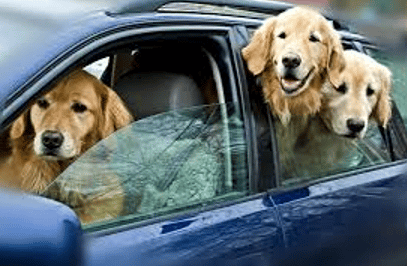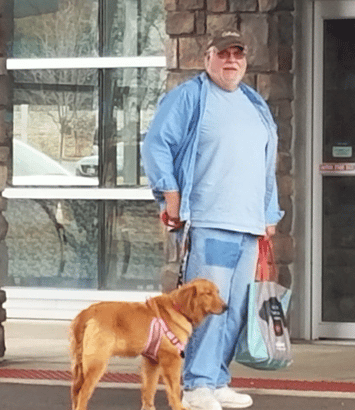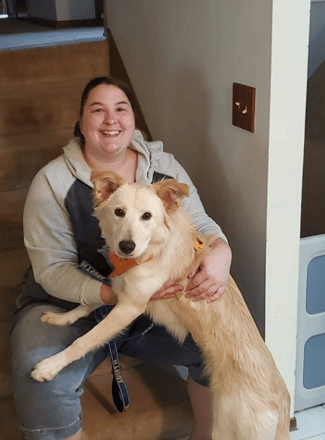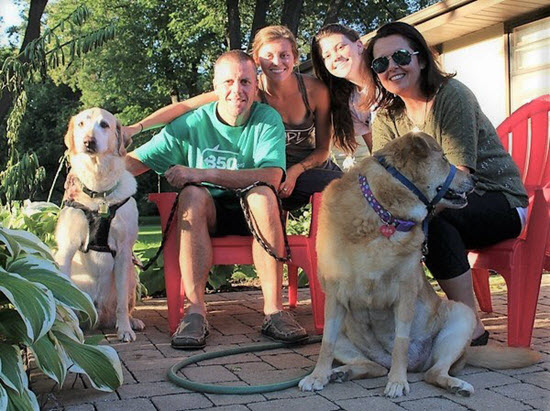When you volunteer for an organization whose mission is to rescue, foster, and find forever homes for Golden Retrievers and Golden mixes in need, you’re bound to embark on an emotional journey or two. From serving as the first point of contact for a family surrendering their Golden, to fostering dogs with seemingly insurmountable trauma, RAGOM volunteers are no strangers to the joy and sorrow that come with helping Goldens find their forever home. Let’s take a closer look at the emotional journeys of some of our RAGOM volunteers.

Mary, hotline volunteer
Mary, a RAGOM volunteer since 2012, does transport, home visits, foster care (22 so far!), mentoring and hotline. Of her many roles, she says foster care and hotline are her favorites.
Hotline is the first point of contact for those looking to surrender their dogs. The hotline volunteer talks to the surrendering owner to get as many details as possible about the dog and reason for surrender. The hotline volunteer then passes that information to the intake team to find a foster and arrange for the dog’s surrender.
Mary began volunteering in hotline after her dog passed away and the emotional toll it took was immediate.
“On my second or third day, I called Kathy and said, ‘I can’t do this,’” said Mary. “Kathy said, ‘Yes you can.’ And I’ve been doing it ever since.”
Mary says that hotline volunteers do a lot of listening. Surrendering owners who call in are usually very distressed—sometimes angry but mostly just really, really sad and in need of consoling. Mary leaves the judgement at the door.
“Many times, the surrendering owner doesn’t want to have to give up the dog, but finances, a medical condition or losing a home leave the owner no choice,” said Mary.
Occasionally hotline volunteers get calls from people whose dog is clearly living in a bad situation. In those cases, RAGOM works feverishly to get the dog out of its current environment immediately, even if it means boarding it while they look for a foster.
“You hear a lot of sad stories,” said Mary. “Some nights you don’t sleep very well. You have to be the advocate and the mouthpiece for the dog until the foster takes over.”
Hotline volunteers document their conversations with surrendering owners, but Mary says sometimes the story she captures on the intake form is only a small part of what she hears.
When asked if hotline took an emotional toll on her, she said, “In the beginning, you cry a lot. As time passes, it’s all about the dog. You need to put the emotion on a different plate, and the plate in front of me is ‘I have to get the dog into RAGOM’s care.’”

Laurie, lead transport coordinator
After hotline captures the information about the dog being surrendered, the intake team sends out a daily plea requesting foster volunteers. The dog’s disposition, needs and previous living environment are all taken into consideration when determining a suitable foster home. After intake finds the right foster home, they pass all the information—about the dog and the surrendering and foster homes—to a transport coordinator like Laurie.
Laurie has volunteered for RAGOM since 2009. She began as a foster and transport volunteer and is now a temporary foster and the lead transport coordinator. Her job is to arrange for the dog to get from its surrendering home to its foster home.
Her most memorable volunteer experience was about two years ago, when RAGOM received a call about 13 Oklahoma dogs needing a home. Their surrendering owner, who loved them very much and gave them all a good life, had to go into a nursing home.
The rescue organization in Oklahoma drove all 13 dogs to Minnesota in a van. Laurie and a group of RAGOM volunteers met them in a Walmart parking lot, but because of bad weather, seven of the planned foster volunteers couldn’t make it to pick up their dogs. So Laurie ended up taking all seven dogs home with her that evening.
“It was crazy but wonderful,” said Laurie. “It was freezing cold, but the dogs were amazing and handled the transport so well.”
The next day, the dogs went to each of their foster homes. But as soon as the dogs got to their foster homes, they shut down because they were missing their pack. So, over the next month, Laurie took four of the dogs back until they became settled enough that they could successfully separate from each other.
“I cried for every goodbye,” said Laurie.

After Laurie (or one of the other four transport coordinators) receives details about the surrendering dog, she reaches out to transport volunteers—like husband-and-wife team Lloyd and Jeri—to coordinate the various legs of the drive from the surrendering home to the foster home.
RAGOM volunteers since 2011, Lloyd and Jeri have volunteered in hotline, transport, home visits, screening and foster care. They enjoy transport the most because they get to meet a lot of different dogs and spend time together on the road.
Lloyd and Jeri say that when they first pick up a dog to transport, the dog is stressed. But they’ve found that Goldens have an exceptional ability to maintain joy in the face of trauma (Lloyd and Jeri also volunteer to do transport for other rescue organizations). Case in point: The dogs rescued from Turkey spent 24 hours in a crate and still came out happy with their tails wagging.
The first leg of the trip can be the most challenging, especially when the owners are devastated about surrendering their dogs because of unavoidable hardships. Lloyd and Jeri say it’s certainly an emotional experience but ultimately one that is rewarding.
“When it’s hard, the good thing is you know the dog is going to a good home in the end,” said Lloyd. “They’ll be medically taken care of, then have a good foster home and a good forever home, where they’ll be loved and cared for.”

Karen, foster volunteer
Karen, a RAGOM volunteer since 2005, is one such foster volunteer who receives the dogs Lloyd and Jeri transport. In addition to fostering, Karen is also a RAGOM volunteer vet coordinator and member of the behavioral services team.
Karen’s first RAGOM foster pup in 2005 was a Hurricane Katrina dog. Since then, she estimates she’s fostered anywhere from 30–50 dogs.
When asked how she would describe the emotional aspect of fostering, Karen said, “When I foster a dog, I know the first few weeks can be pretty tough. But when I see the dog start making progress, it is totally worth it.”
Karen also serves as support for struggling new fosters. “I tell them that when fostering a dog, I almost always feel overwhelmed and teary at some point during the first week,” said Karen. “They are relieved to hear that it’s hard for all of us—they assume it’s just them, or that particular dog.”
All dogs who come into RAGOM’s foster care have just had their entire life turned upside down. It’s no surprise, then, that the most rewarding aspect of fostering is when, after the first few weeks, the dog starts to flourish. By the time the dog is adopted out to its forever family, Karen says foster volunteers almost certainly cry again—but this time tears of joy because they love the foster dog so much and know they have given that dog a new chance at a happy life.
“This is why we do it again and again,” said Karen. “It’s so gratifying!”
If you’d like to join our mighty village of more than 300 RAGOM volunteers, please check out our volunteer openings.

